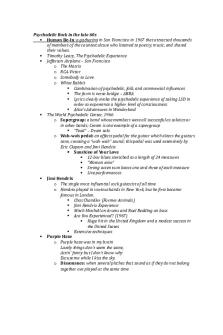Music Appreciation Notes #1 Prehistoric Music PDF

| Title | Music Appreciation Notes #1 Prehistoric Music |
|---|---|
| Course | Music Appreciation |
| Institution | Diablo Valley College |
| Pages | 2 |
| File Size | 129.2 KB |
| File Type | |
| Total Downloads | 48 |
| Total Views | 140 |
Summary
NOTES FROM THE LECTURES 1-5. They are entirely original and are pretty basic stuff from musical notes to scales....
Description
●
●
● ● ● ● ● ●
● ●
●
●
● ●
Sound waves are created when gas feels the pull of dark matter and condenses in one spot and when in motion or when the gas is pushed out it overshoots and then falls back in which creates a pressure wave, this continues creating oscillating pressure waves aka a sound wave. Rhythm is just movement of sound through time in a consistent pattern and when sped up you can’t hear the individual impulses of sound anymore which transforms it form rhythm to pitch Humans can hear pitches from 20 to 20,000 cycles of vibrations per second anything higher is dog whistle range, below is elephant range. The fatter, wider, looser, bigger something is the lower the pitch. Vice versa Higher the Frequency, Higher the pitch. Dynamics control softness and loudness, the larger the amplitude the louder the sound Timbre = Tone Color, refers to a pitch sounding different between different instruments. Tone Quality depends on the stage of the note and how it’s delivered ○ Stages of a pitch overtime ■ Attack- How quickly a sound reaches full volume after it begins ■ Decay how quickly the sound drops after the initial peak ■ Sustain- The steadiness of the sound after it’s attack ■ Release- How quickly the sound fades. The more pitches add up to create a noise (or a chord/note) Half steps are each notes up and down a scale (including sharps/flats)
For men to sing a higher note like C they have to start at the higher end range of their voice and have to sing higher pitch compared to women because higher notes come easier to them (vice versa for men) allowing them to not have to sing such a higher pitch for higher notes. C major scale starts and the C note and goes C,D,E,F,G,A,B,C from C to C increasing in pitch. In this case the Tonic Note or key note is C, you can do mary had a little lamb on the c scale. pattern would be the same as on a A or B scale you just start 1-8 from the key note. so translating the notes to numbers to 1,2,3,4,5,6,7,8; 1 to 8 instead of C to C you can translates songs across any scale Solfege is the words under notes on a sheet of music. Bar Lines are the lines on the sheet of music that acknowledge pitch
●
(Your Notes but I find them useful)Five Basic Ways of Producing Sound ○ ○ ○ ○ ○
Wind (Aerophone) - (Flute, Oboe, Clarinet, Trumpet) Solid-Body (Idiophone) - (Woodblock, Cymbal) Drum (Membranophone) - (Timpani) String (Chordophone) - (Harp, Piano, Violin) Electricity (Electrophone) - (Synthesizer)...
Similar Free PDFs

Music Appreciation
- 1 Pages

Music Appreciation Notes
- 2 Pages

Music Appreciation Notes Feb. 25
- 2 Pages

Music Appreciation Notes Feb. 9
- 2 Pages

Music Appreciation test 2
- 8 Pages

Music Appreciation Final Essay
- 3 Pages

Music notes
- 24 Pages

Music Concepts - Music Timeline
- 1 Pages

African music quiz 1 notes
- 16 Pages
Popular Institutions
- Tinajero National High School - Annex
- Politeknik Caltex Riau
- Yokohama City University
- SGT University
- University of Al-Qadisiyah
- Divine Word College of Vigan
- Techniek College Rotterdam
- Universidade de Santiago
- Universiti Teknologi MARA Cawangan Johor Kampus Pasir Gudang
- Poltekkes Kemenkes Yogyakarta
- Baguio City National High School
- Colegio san marcos
- preparatoria uno
- Centro de Bachillerato Tecnológico Industrial y de Servicios No. 107
- Dalian Maritime University
- Quang Trung Secondary School
- Colegio Tecnológico en Informática
- Corporación Regional de Educación Superior
- Grupo CEDVA
- Dar Al Uloom University
- Centro de Estudios Preuniversitarios de la Universidad Nacional de Ingeniería
- 上智大学
- Aakash International School, Nuna Majara
- San Felipe Neri Catholic School
- Kang Chiao International School - New Taipei City
- Misamis Occidental National High School
- Institución Educativa Escuela Normal Juan Ladrilleros
- Kolehiyo ng Pantukan
- Batanes State College
- Instituto Continental
- Sekolah Menengah Kejuruan Kesehatan Kaltara (Tarakan)
- Colegio de La Inmaculada Concepcion - Cebu






